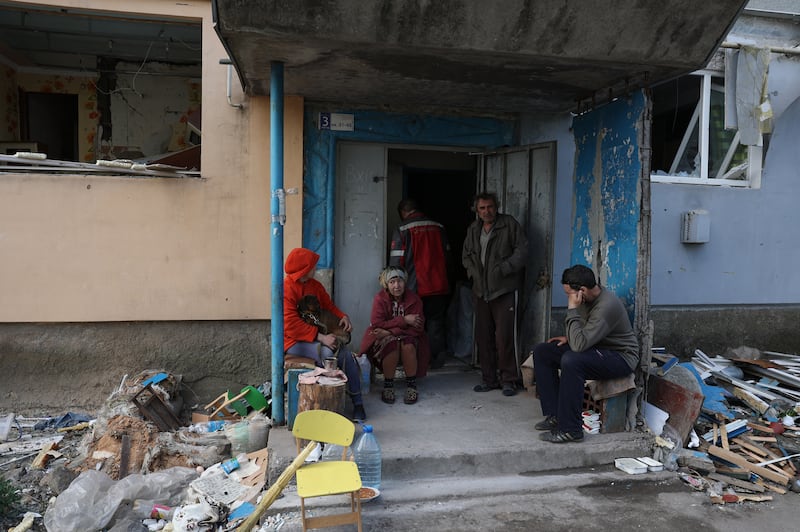Russia has consolidated recent battlefield gains in the east of Ukraine, and is attempting to break through Ukrainian defensive lines before a long-awaited package of US military assistance arrives at the front line.
On Sunday Russian troops advanced near the city of Avdiivka. They seized two villages and expanded a narrow corridor around the rural settlement of Ocheretyne, which the Russians entered a week ago. Ukrainian security officials described the situation in the Donbas region where Russia is attacking on multiple fronts as “very difficult”. It was “not critical or catastrophic”, they added.
The fighting in Ocheretyne followed a surprise Russian attack. The manoeuvre enabled Russian combat units to bypass a network of Ukrainian trenches and establish a salient. They have since overrun neighbouring hamlets – Solovyove and Novokalynove – and are attempting to push farther west.
Ukraine’s eastern command said its forces controlled two-thirds of Ocheretyne, where there was fierce fighting.
The New Nuclear Age by Ankit Panda: Could ‘growing loose talk’ lead to the ultimate disaster?
Looking at Women Looking at War by Victoria Amelina: Valuable, vivid, frustrating
US envoy hails Ukraine’s ‘courageous’ leader as talks ‘restore hope’ for Kyiv after bruising week
Thanks to Trump, Saudi Arabia gets a big week in international diplomacy
Russia seized Avdiivka in February after Ukrainian troops withdrew. Moscow’s forces have been advancing ever since. Northwest of Avdiivka, Russian brigades have come within about 18 miles (30km) of the city of Pokrovsk, a Ukrainian military hub. Farther north, they are assaulting the town of Chasiv Yar, near Bakhmut, using airdropped glide bombs to pound Ukrainian positions.
“Right now things are not critical or catastrophic. But it’s very difficult,” one senior security official in Kyiv said on Sunday.
The person said it would take “one to two months” before $61 billion (€57 billion) of US military aid reached frontline troops and allowed them to counter Russian attacks. Some weapons such as 155mm artillery ammunition would arrive sooner, officials suggested.
According to the Institute for the Study of War (ISW), the Kremlin is seeking to exploit a window of opportunity before US assistance is delivered. Moscow has been bringing in reinforcements and has a threefold advantage in some sectors. Its recent tactical gains suggest an ambitious plan to encircle the Ukrainian garrison cities of Sloviansk and Kramatorsk in a summer offensive. Whether it will succeed is unclear. Russia was unlikely to overwhelm Ukrainian defences, the ISW said last week.
“The arrival of US aid at the front in the coming weeks will allow the Ukrainian forces to address their current material constraints and blunt ongoing Russian offensive operations. Russian forces appear to be intensifying efforts to destabilise Ukrainian defences and gain ground,” it said.

Security officials believe Vladimir Putin’s original war aims are unchanged, more than two years after his full-scale invasion. They include seizing the cities of Kyiv, Kharkiv and Odessa and occupying Ukraine’s southern Black Sea coast. They assess that Russia will not be able to storm Kharkiv, a city of more than 1 million people close to the Russian border, but will continue to bomb and to threaten it.
The officials suggest the next few months will be critical. Ukrainian service personnel complain that they are completely outgunned. Russia is able to fire at least six shells for every salvo sent by Ukraine in return. Stocks of Soviet-era anti-aircraft missiles ran out long ago, with Russian warplanes able to operate freely close to the front line. Ukraine has fewer tanks and armoured vehicles.
In recent months Moscow has repeatedly targeted Ukrainian infrastructure. A missile attack on Saturday hammered power facilities in central and western Ukraine. DTEK, the country’s largest private electricity company, said four of its six thermal power plants were damaged. Rescuers put out fires at energy facilities in the western regions of Lviv and Ivano-Frankivsk, the company said.
Early on Sunday, Russian drones hit a hotel in the southern port city of Mykolaiv, said Vitaliy Kim, the region’s governor. A heat-generating plant was also damaged, he added.
Russia claimed it was targeting “English-speaking mercenaries”. It used the same formula to describe ballistic missile strikes earlier this year on hotels in Kharkiv, where several foreign journalists and local staff were injured.
Russia said it shot down 17 enemy drones above its territory. There were unconfirmed reports that the Ukrainian military had struck a Russian air defence unit at Cape Tarkhankut, on the western coast of occupied Crimea. Long-range ATACMS missiles supplied this month by the US were used, Telegram channels said.
Explosions were reported in the northern Crimean town of Dzhankoye, after a previous attack there on an airfield and Russian missile launcher system.
Ukraine’s armed forces frequently carry out strikes on Crimea and have used sea drones to drive out Russian’s Black Sea fleet from the port of Sevastopol. Intelligence officials indicate they intend to blow up the road and rail bridge connecting the occupied peninsula with Russia.
On Sunday, Lithuania’s former foreign minister, Linas Linkevičius, joked that the bridge would soon vanish, posting on X: “If someone hasn’t had time to take a photo on the Kerch Bridge, there is still time,” with photos of a rocket and Putin scratching his head.
Moscow was furious. Dmitry Polyansky, Russia’s representative to the UN, called Linkevičius an “obedient Baltic slave of the USA”. The Russian diplomat said the former minister – now Lithuania’s ambassador to Sweden – would regret his words on “judgment day”.












